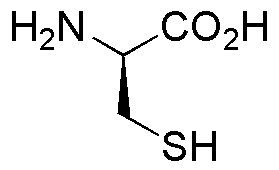D-Cysteine is widely utilized in research focused on
- Biotechnology: It serves as a crucial building block for synthesizing peptides and proteins, enhancing the development of biopharmaceuticals.
- Antioxidant Applications: D-Cysteine is known for its antioxidant properties, making it valuable in formulations aimed at reducing oxidative stress in various health products.
- Food Industry: It is used as a flavor enhancer and preservative, improving the shelf life and taste of processed foods.
- Cosmetics: The compound is incorporated into skincare products for its skin-repairing and anti-aging benefits, promoting healthier skin.
- Research and Development: D-Cysteine plays a role in studying metabolic pathways and cellular functions, aiding researchers in understanding various diseases.
General Information
Properties
Safety and Regulations
Applications
D-Cysteine is widely utilized in research focused on
- Biotechnology: It serves as a crucial building block for synthesizing peptides and proteins, enhancing the development of biopharmaceuticals.
- Antioxidant Applications: D-Cysteine is known for its antioxidant properties, making it valuable in formulations aimed at reducing oxidative stress in various health products.
- Food Industry: It is used as a flavor enhancer and preservative, improving the shelf life and taste of processed foods.
- Cosmetics: The compound is incorporated into skincare products for its skin-repairing and anti-aging benefits, promoting healthier skin.
- Research and Development: D-Cysteine plays a role in studying metabolic pathways and cellular functions, aiding researchers in understanding various diseases.
Documents
Safety Data Sheets (SDS)
The SDS provides comprehensive safety information on handling, storage, and disposal of the product.
Product Specification (PS)
The PS provides a comprehensive breakdown of the product’s properties, including chemical composition, physical state, purity, and storage requirements. It also details acceptable quality ranges and the product's intended applications.
Certificates of Analysis (COA)
Search for Certificates of Analysis (COA) by entering the products Lot Number. Lot and Batch Numbers can be found on a product’s label following the words ‘Lot’ or ‘Batch’.
*Catalog Number
*Lot Number
Certificates Of Origin (COO)
This COO confirms the country where the product was manufactured, and also details the materials and components used in it and whether it is derived from natural, synthetic, or other specific sources. This certificate may be required for customs, trade, and regulatory compliance.
*Catalog Number
*Lot Number
Safety Data Sheets (SDS)
The SDS provides comprehensive safety information on handling, storage, and disposal of the product.
DownloadProduct Specification (PS)
The PS provides a comprehensive breakdown of the product’s properties, including chemical composition, physical state, purity, and storage requirements. It also details acceptable quality ranges and the product's intended applications.
DownloadCertificates of Analysis (COA)
Search for Certificates of Analysis (COA) by entering the products Lot Number. Lot and Batch Numbers can be found on a product’s label following the words ‘Lot’ or ‘Batch’.
*Catalog Number
*Lot Number
Certificates Of Origin (COO)
This COO confirms the country where the product was manufactured, and also details the materials and components used in it and whether it is derived from natural, synthetic, or other specific sources. This certificate may be required for customs, trade, and regulatory compliance.


